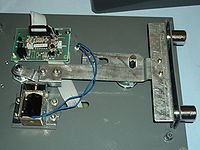Electronic lock: Difference between revisions
Nickinator (talk | contribs) (Added photo and a bit of info on electronic keying systems and electronic safes.) |
m (PageName/TOC fix) |
||
| Line 1: | Line 1: | ||
= | <span style="font-size: 188%;">{{PAGENAME}}</span> | ||
---- | |||
An '''electronic lock''' (or '''digital lock''', '''electric lock''') is a form of [[Lock|lock]] that uses electricity as an integral component in the locking and unlocking of the lock. Many electronic locks does not use [[Key|keys]] and are instead [[Combination|combination]] based. | An '''electronic lock''' (or '''digital lock''', '''electric lock''') is a form of [[Lock|lock]] that uses electricity as an integral component in the locking and unlocking of the lock. Many electronic locks does not use [[Key|keys]] and are instead [[Combination|combination]] based. | ||
| Line 22: | Line 23: | ||
Electronic Safes function in much the same way, a keypad or human interface device sends the entered code to the mainboard, which compares the entered combination with the combination stored on the EPPROM, if it is, the mainboard applies current to the solenoid, causing the bolt that lies in it to retract allowing the locking bolt to be retracted. | Electronic Safes function in much the same way, a keypad or human interface device sends the entered code to the mainboard, which compares the entered combination with the combination stored on the EPPROM, if it is, the mainboard applies current to the solenoid, causing the bolt that lies in it to retract allowing the locking bolt to be retracted. | ||
<br clear="all"> | |||
== See also == | == See also == | ||
Latest revision as of 15:37, 19 December 2022
Electronic lock
An electronic lock (or digital lock, electric lock) is a form of lock that uses electricity as an integral component in the locking and unlocking of the lock. Many electronic locks does not use keys and are instead combination based.
Electromechanical locks use both electronic and mechanical locking components.
Add to me!
History
Add to me!
Principles of Operation
Electronic locks function in various different ways, but most use an electronic solenoid to prevent entry, and to allow entry when required.
Locks such as the Videx Cyberlock and the ASSA QLIQ employ a digital communication between the lock cylinder and the key, if authenticated the solenoid retracts, allowing the plug to turn in the lock.
Electronic Safes function in much the same way, a keypad or human interface device sends the entered code to the mainboard, which compares the entered combination with the combination stored on the EPPROM, if it is, the mainboard applies current to the solenoid, causing the bolt that lies in it to retract allowing the locking bolt to be retracted.
See also
| This article is a stub. You can help Lockwiki by expanding it. |

